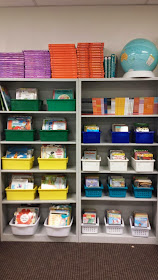And, I have spent SOOO much money on my classroom already this summer, I couldn't spend any more on new bookshelves. So, I have to make due with the two ugly metal ones that the district provides (well, they provide one and I sort of took the other one from my kinder classroom...but don't tell). Here's a picture of all my boxes of books on the ugly metal shelves.
My next problem is how to display them??? I bought some cute bins, but again, spending too much money, so I had to use the ones that came in the cubbies. I think the students used them as storage boxes for their stuff because they were NASTY!!!
After about three hours in the classroom today (Saturday), I have them looking pretty...
But they are not organized at all! The chapter books are organized by AR levels (sort of) but the picture books are just randomly in tubs. My next question is "How do I want to organize the books?" I see the benefit of AR leveled tubs because students can find the tub that is at their level and choose from those... BUT, part of me wants to organize some/most of the books by author/series. That's the real way libraries are organized and I think it's valuable they see this organization in the classroom as well. I think I was reading in the Daily 5 book, or somewhere, and the authors mentioned a student (I think he had recently moved to the U.S.) who had a classroom library organized by levels. When that student went to the public library, he was very confused and frustrated because he couldn't find a book in his AR level. Funny story, but it makes you think about how inauthentic it is to organize the library that way. On the other hand, I know how messy students can be in the library AND if the books are organized by levels (the books have colored dots on the spines) then it is easier to maintain books in the correct locations... So, I don't know how I am ultimately going to organize the books! But, it's a lot to think about.
One of our first week activities is to organize the library. I give each table a couple of tubs of books and together we figure out an organizational system. We organize the holiday books, the fairy tales, the books with animals as main characters etc...I've done this mostly with the picture books but this year I will also do it with chapter books. Maybe I will just let the students decide- or do a combination of both- organize the chapter books within that level range by author/series but still maintain the AR level ranges.
I do this as a beginning of the year activity because it gives students ownership into the classroom. We talk about treating books correctly and how to maintain the library. Students get to see all the cool books I have, and it's fun too! It's a little crazy and chaotic with books all over the place, but I think it's worth it! Once we do the organizing then I have pretty labels that will go on the bins.
Happy Reading!
Karla












































